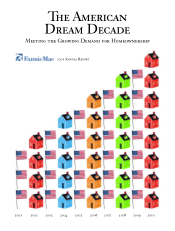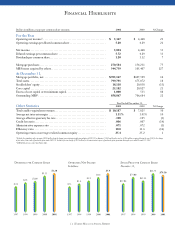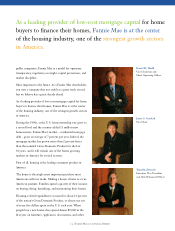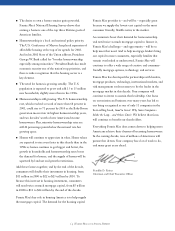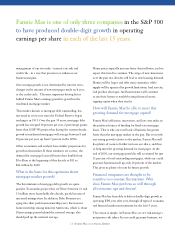Fannie Mae 2001 Annual Report Download - page 11
Download and view the complete annual report
Please find page 11 of the 2001 Fannie Mae annual report below. You can navigate through the pages in the report by either clicking on the pages listed below, or by using the keyword search tool below to find specific information within the annual report.
examinations – which
other regulators do not
do. But Fannie Mae adds
to these disclosures. In
2001, we put into place
a set of voluntary
initiatives to regularly
disclose key details about
our business and risk
management, including
regular reports about our credit risk and interest rate risk
exposure. We also began issuing subordinated debt, whose
price is sensitive to how the market views our financial
condition. Fannie Mae now gives more information, more
frequently, on more aspects of our financial condition and risk
management than any other financial institution in America.
{ 9} Fannie Mae 2001 Annual Report
Fannie Mae operates under one of the most stringent
safety and soundness regimes of any financial institution
in America.
We have a highly disciplined approach to managing interest
rate risk on our mortgage portfolio, and we have a decade
and a half record of successful results as testimony to the
effectiveness of this approach.
Fannie Mae has been called “a new global
model” for financial institution safety,
soundness, transparency, and market discipline.
Why is that, and why is that important?
Fannie Mae’s mission involves raising low-cost capital for
U.S. housing from investors across the globe. For this to be
done with maximum success, investors need to understand
and have confidence in Fannie Mae’s financial strength and
stability. Regulatory oversight, an ample capital cushion
against risk, and maximum transparency and financial
disclosure are critical underpinnings of this understanding
and confidence.
Fannie Mae operates under one of the most stringent safety
and soundness regimes of any financial institution in
America. While most financial institutions hold capital
to meet a “leverage” ratio – a ratio of capital to assets –
Fannie Mae has both a minimum leverage ratio and a
risk-based capital standard with a stress test. Under the
risk-based standard, we are required to hold enough capital
to withstand extraordinarily severe credit conditions and
unprecedented interest rate swings assumed to persist
for 10 years. We also must hold an additional 30 percent
capital cushion on top of that.
Fannie Mae’s financial regulator conducts on-site
examinations and makes an annual report of these

